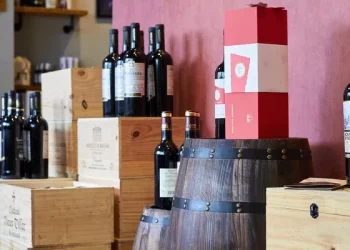When it comes to sweet wines, many wine lovers will probably think of rich wine, ice wine and port, but have you heard of holy wine?
Holy wine is a wine made from dried grapes with an attractive oxidized flavor, usually sweet.
It is the characteristic wine of Italy and has a very long history.
At present, holy wine is produced in many places in Italy, but generally in Tuscany (Tuscany) is the most classic and famous.
The name “Vin Santo” is a paraphrase of its foreign name.
There are many different theories about how Vin Santo got its name.
For example, many people believe that it was the wine used in the Catholic Mass service at that time, so it was respectfully called “holy wine”.
Some people believe that the wine grapes are usually dried before Halloween or Christmas, and the finished wine is also bottled around Easter, so the name “holy wine”.
Another plausible explanation is that the medieval city of Venice, Italy, once had jurisdiction over the Greek island of Santorini, and as a result produces insanto (also translated as “holy wine” but made in different ways and styles), its famous sweet wine.
In addition, there are many other interesting theories circulating in the wine industry, such as the high sugar content of the wine, seems to have innate divine power, can help patients recover faster, so it is called “holy wine”.
There are many varieties of holy wine, including all the representative varieties of Italian regions.
They are usually white grape varieties, the most common of which are Trebbiano and Maasia.
Tuscany’s sacred wines must be blended with these two attractive varietals, and many of the regions have a minimum blend requirement.
There are also peach versions, called Occhio di Pernice (Partridge eye), which are generally made from Sangiovese, the most famous of which is from the Montepulciano region of Tuscany.
The uniqueness of holy wine is mainly related to its brewing technology.
From September to October of each year, the wine grapes of holy wine will be placed on a straw mat or hung under a roof beam after harvest, and air dried for 3-6 months or so, until the grapes are dried up due to evaporation of water (the volume will be reduced to about 40% of the original), and the sugar and flavor will be extremely concentrated.
During this time, many will check the humidity daily to make sure the grapes are drying smoothly.
After drying, the shriveled grapes are pressed to produce a dense, precious juice.
The juice is then fermented by alcohol in small wooden barrels (usually 50 litres) called Caratelli.
Due to the highly concentrated sugar content of grape juice, the fermentation process is slow and usually lasts 1-3 months.
To make the fermentation process more smooth, wineries often use a “Madre” (a mixture of the previous year’s holy wine and the yeast left over from the previous year’s fermentation) to start fermentation.
After fermentation, the wine continues to age for a long time in small wooden casks.
Traditionally, kegs of chestnut wood, rich in tannins and permeability is strong in the process of aging will be sealed, so the wine can’t add barrels (Top Up, namely add fresh during aging, to fill the loss due to evaporation of that part of the wine juice), allows more oxygen to the small bucket, so as to accelerate the process of evaporation of liquid,
And give liquor nuts, caramel and other oxidation flavor.
Today, however, many producers also use other woods, such as oak, to make holy wine;
They also often add barrels during aging to give the wine a nutty flavor while keeping it fresh.
In many regions of Italy, holy wines must be aged for at least three years before they can be sold, but in practice, many chateaus produce holy wines that are aged well beyond the legal limit to further enhance complexity and intensity.
Holy wine is usually a sweet wine.
However, a very small amount of dry sacred wine exists.
This sacred wine is fermented long enough that almost all the sugar in the final liquor is converted to alcohol, resulting in a dry wine.
In its most classic sweet style, holy wine comes in a variety of colors, ranging from pale straw gold to deep amber to bright orange.
They usually have complex aromas of hazelnuts, caramel, honey, dried apricots and tropical fruits. They are full bodied, sweet and mellow. They are often enjoyed with a local hard biscuit and are widely loved in Italy as an afternoon tea.
All in all, if you have the chance to taste this unique sweet wine, don’t miss it.
The latest market dynamics at any time to see, please pay attention to.












































